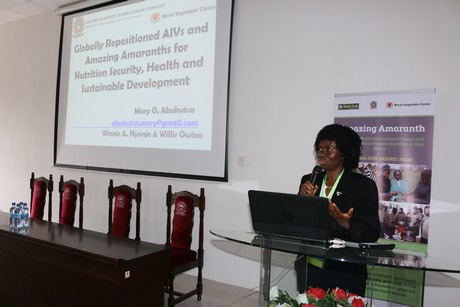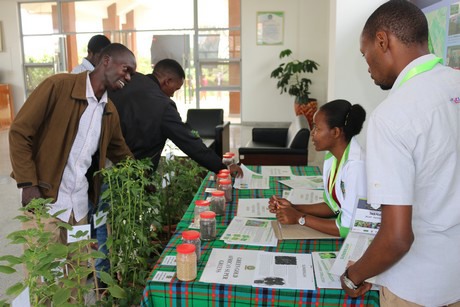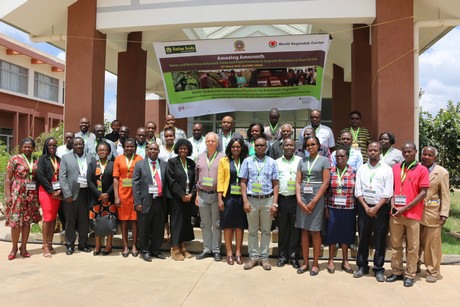The African Indigenous Vegetables (AIVs) have immense potential that can be harnessed by various stakeholders to contribute to the nutritional security, health and sustainable development of the country yet their exploitation and consumption across Africa still remains worryingly low.
This was revealed during a-one day stakeholders’ workshop convened by the World Vegetable Centre/AVRDC in collaboration with Jomo Kenyatta University of Agriculture and Technology (JKUAT) under the Amazing Amaranth Project – that seeks to enhance the use of amaranth germplasm and adopt high nutritional value as a breeding objective while forging strong partnerships with key value chain actors to enable smallholder farmers and consumers to reap the benefits of increased amaranth production and consumption.
Speaking Friday, March 15, 2018 to farmers from various parts of the country such as Kiambu and Vihiga, traders, seed processors, consumers and marketers and the media, Prof. Mary Abukutsa, who is the Principal Investigator for the JKUAT research team, made a strong case for the amaranth, noting the researchers are keen to “re-position AIVs and the amaranths for nutritional security, health and sustainable development.”

Prof. Abukutsa makes her presentation
Decrying the poor consumption levels of AIVs in Africa, Prof. Abukutsa stated the quantity uptake of the indigenous vegetables was still low, against the minimum recommended level of 73 kg/ person per year, with statistics indicating Nigeria leading at 60kgs/per person per year, followed by Kenya, with a person consuming below 40 kgs annually, while Uganda, Ethiopia, Democratic Republic of Congo and Mozambique were identified as countries with the lowest consumption rates of below 20 kgs/person annually.
According to Prof. Abukutsa, the inherent potential of the AIVs can be harnessed “to reduce incidence of diet related diseases, provide essential micro-nutrients and fibre, alleviation of malnutrition, and high anti-oxidant content. “The AIVs provide new income opportunities that could be the engine to drive economic growth,” Prof. Abukutsa stated.

Participants at the AIVs Exhibition Stand
Project Manager for the Amazing Amaranth Project, Dr. Roland Schafleitner, noted that it was exciting to have key stakeholders on one platform to share experiences and explore opportunities and constraints in the amaranth value chains.
Dr. Schafleitner, said the amaranth vegetables, besides being protein rich (over 16%), have balanced amino acid content, calcium, potassium, iron, vitamin A and C, are easy to grow, are heat and drought tolerant and susceptible to few disease attack.
He identified breeding, varieties seed supply and anti-nutrient content as some of the major constrains to the exploitation of amaranth vegetables.
The project envisages that by the year 2022, about 135,000 farm households in Kenya and Tanzania will have adopted improved amaranth cultivars, 530 hectares of agricultural land will be under improved amaranth cultivars, 460,000 consumers in Kenya and Tanzania will adopt improved amaranth food preparation methods and about 140,000 women of reproductive age and children under 5 years will increase their consumption of amaranth as part of a healthy and diverse diet.
Dr. Christine Chege of the Centre of International Tropical Agriculture (CIAT), reported that her organization had applied the Nutrition Sensitive Value Chain (NSVC) approach to understand how to systematically mainstream nutrition in agricultural value chains.
She identified “lack of access to land and financing, insufficient irrigation water, dysfunctional seed system, low prices and technical skills on amaranth production as some of the constraints facing producers” while consumers are grappling with high prices, poor quality, inconsistent supply of vegetables whose safety cannot be guaranteed. She called for a review of the seed system to ensure improved seeds are accessed by producers, breeding of new varieties, sensitization of the public on vegetable contamination and market systems.

The Indigenous African Vegetables stakeholders after the workshop opening session at JKUAT
Farmers appealed for assistance in accessing quality seeds, better markets and financing during the meeting that was also attended by Ministry of Agriculture representatives. Participants also called for policy shift in addressing the bottlenecks facing the AIVs sector.
Vegetable amaranth is a popular leafy vegetable crop grown and consumed in many parts of Kenya. The leaves are among the most nutritious leafy vegetables, rich in protein, vitamins and mineral salts. Their fast growth and great biomass make them some of the most high-yielding vegetables, meaning more leaves for consumption and selling.
Source: Yomo Kenyatta University of Agriculture and Technology
